Genre: RPG Developer: Atlus Publisher: SIMS Co. Players: 1 Released: 1994
No doubt about it: Atlus’ Megami Tensei franchise of RPGs (often abbreviated to MegaTen) is friggin’ huge! The series originally started out as a simple dungeon crawler for MSX home computers in 1987, based off a relatively simple (and frankly, pretty pulpy) science fiction novel about a teenager summoning demons through his PC. Last time I checked though, there are now more than 50 different games carrying that name (RPGs and otherwise, including several spin-off-series), and it doesn’t look like its popularity is going to wind down any time soon. That’s pretty amazing, especially if you consider that the series wasn’t even officially released outside of Japan until 1996, when the first game in the Persona side series (and the 16th! overall going by release schedule) reached the PSX (well okay, there also was the spin-off Jack Bros. for the Virtual Boy, but that doesn’t really count for so many reasons…).
Today’s subject, Shin Megami Tensei (literally translated to “True Resurrection of the Goddess”) is technically the third game in the series, though this RPG was only loosely based on its original source material and took the burgeoning franchise in an entirely new direction. Originally released for the Super Famicon in 1992, it soon turned out to be a smash hit, being one of the first ten games to reach a score of 36 or higher in the renowned Famitsu magazine up until that point. Over the following years, it also received a number of enhanced ports for the PC-Engine, the Mega CD, and the PlayStation; none of which were ever officially translated into English until eventually a smart phone port hit mobile stores in 2014!
So, if that series was so immensely popular in its home country, why did it take over 20 years for a worldwide release? Well, there is a reason for that, though it’s a rather unfortunate one. A word of warning, there will be some minor spoilers in this review. If you want to go into the plot entirely unprepared and unspoiled, you had better jump right to the last paragraph.
Shin Megami Tensei starts out in a weird dreamscape. Automatically stumbling through a hazy labyrinth, you, the nameless protagonist, first encounter a crucified man, then another person beset by demons – and finally a naked, blue-haired woman, who seems to recognize you and declares her everlasting love for you. Before this intriguing encounter can progress any further though, our hero awakens into present-day Japan. Things are off to a slow start – your mother sends you on an errand to pick up some coffee at the mall, you get to have some small-talk with your neighbors – but there’s a foreboding sense of dread in the air. On your PC, you find a strange program an unknown person sent out on an Internet bulletin board. The police have closed down most roads in the neighborhood, since there apparently had been a murder the previous night. While on your errand, you suddenly run into the woman of your dreams, who disappears as enigmatically as she came. And while exploring the mall, a mugger attacks you – before he suddenly gets offed himself by demon popping up out of nowhere. Before you know it, strange creatures are popping up everywhere, girls are getting kidnapped, and things start going to hell in a number of ways, some quite literal – and you and the people you’ve met in your dreams are suddenly caught up smack-dab in the middle of it.
This may sound like your typical “average teenager gets to save the world” at first glance, but it distinguishes itself from the trope in a number of ways. First, there’s the setting, which, even though it’s conveyed by early-to-mid ‘90s tech, is recognizably meant to be present day in the real world, with real-world issues and politics and suddenly beset by demonic beings. Once you start to advance and get to grasp what is actually going on, the plot hits you with a stomach-churning twist so out of left field that it sends you reeling, and that’s still very early in the game. There are quite a lot of these twists and turns in place, and the fact that it’s recognizably meant to resemble the ordinary real world at first makes all of these events hit home even stronger.
Also, the game holds quite a lot of replayability. There’s a major conflict in the entire game, and the way the story progresses is in some key events strongly dependent on your playstyle. It’s not your standard “good vs. evil” morality system. “Lawful vs. chaotic” would be a more fitting description (also represented by the mannerisms and ethics of your party members, which some guides refer to as the “Law Hero” and the “Chaos Hero,” respectively). What it basically boils down to is this: Would you rather search safety in a strict, obedient society, where those following the mandated law to the letter are protected while all those opposing it or not fitting in are left out or even destroyed mercilessly? Do you rather believe in a “survival of the fittest” attitude, where everyone is allowed their own liberty and individuality, at the price of a constant fight for survival where the weak tend to get left behind? Or, finally, would you try to find a mediating middle way, causing you to be constantly caught up in the conflicting affairs of the other two sides? There are a number of situations where each of these three paths impact on the plot, and while the overall story still follows roughly the same direction, key events (including the ending) turn out in different ways depending on your decisions. It’s quite a bit different from your usual RPG “morality” system as well. There aren’t really many “true good” or “true evil” choices out there; destruction is rather caused by the clashing views rather than by singular decision – and it’s not like in many modern games, where you get the best rewards by “staying good” or “staying evil.” It’s more like this: It may have been rather anarchic what you just did – but was it really, morally, a bad thing? Or it may be “good” if you sacrifice yourself in the spur of the moment – but how can you really protect anyone in the long run when that happens?
Finally, aside from the story and the setting, there’s also a core gameplay mechanic that makes the game stand out from the fold: Early on, you get a so-called “Demon Summoning Program.” Well, the game says “demons,” but it’s actually more complicated than that. Throughout your journey, you randomly encounter a number of supernatural beings from a huge variety of myth and lore. Some would be your classical western “demons” – succubae and devils. Others are more firmly rooted in Japanese lore – Oni, Kami and other spirits. There are even creatures from Hindu, Celtic, and Greek mythology, like fairies for example. And there are also angelic beings from Christianity and Judaism as well.
In each encounter, you get your typical fight or flee options, but there’s also another possibility: By using your summoning program, you can attempt to talk and negotiate with these creatures. If you’re successful, the supernatural creature joins your cause, allowing you to summon it into your party to fight by your side. All these demons are lawful, chaotic, or neutral in alignment, which also reflects on their attitude towards you. If you’re playing on the chaotic side, you won’t be able to convince an angelic being to join you. Negotiating with a demon is also very different from case to case. Depending on their more general nature (aggressive or timid, flirtatious or cheeky), you also need to apply different strategies when talking to them. Some like to be flattered, others need to be coerced. The outcome can be very different depending on how you talk to each creature. Sometimes they just leave, sometimes they give you something in return, and sometimes they ask for some sort of payment before they are willing to join you. Of course, if you choose poorly or can’t pay the demanded tribute, you may need to fight them nevertheless. The whole demon negotiation thing is made even harder by the fact that it’s entirely in Japanese. While it’s manageable (you usually have two dialog options each turn, with the upper always being a friendly and the lower an aggressive approach), it will take a while until you get the hang of it, especially when demons start asking for items you might or might not have.
You only can convince a demon to join you if he’s got the same or a lower level than your main character. Summoning creatures also costs “MAG,” a kind of secondary currency that diminishes depending on the strength of the demon(s) you’ve currently got by your side. Run out of MAG, and your creatures just up and leave the realm until you’ve got enough to call them again.
This demon summoning mechanic gives the game another layer of depth which clearly distinguishes it from other RPGs of the era. You only have a limited number of slots available for possible summons though, and you also only can have one creature of the same type at once. If you meet the same type of demon again, he usually gives you something upon your next chance meeting. Also, in certain areas you have the ability to merge two of your creatures, creating a new, usually stronger one in the process, with new abilities as well. Mixing and matching the right type of creatures to keep at the ready becomes its own little game in some kind of proto-Pokémon fashion, the main difference being that your demons always stay at the same level and can only be healed magically, so it pays off dismissing or combining weaker creatures regularly. That shouldn’t be too hard, because the encounter rate is damn high – sometimes you can’t go three steps without running into another one!
As you might have grasped, plot and style are rather heavy and mature, especially for the time period the game was made. The sensitivities are also more typically Japanese, which is also why publishers may have felt the game suitable for a release outside of Japan. While the plot isn’t strictly painting Christianity in a negative light, it also tackles certain issues that deeply religious people may find offensive. Regarding religion, the game occasionally enters very tricky territory (in a Milton-esque Paradise Lost kind of way for those who know your English literature). Having devils join your party and being able to attack and kill angels – even, if you choose to do so, named archangels from the bible – is also something that may be easier to get away with in modern market sensitivities, but trying to pull that off among mid- ‘90s sensitivities is a completely different can of worms.
That’s is too bad, because the game has a lot going for it, both plot and gameplay-wise. While the Super Famicom release was very successful in Japan, the Sega CD port improves upon the formula in several ways. Hallways are no longer just identical grey corridors but are actually textured based on their location: A mall looks decidedly different than an apartment complex or a military bunker. Also, while the Super Famicon original was notorious for letting the players get lost constantly, the world map not only shows you which buildings you can enter, but actually tells you their names, so you’re actually able to find your way around and know where you’re going or what places you’ve already been to. This helps to offset the still very high encounter rate somewhat, even though the Sega CD port offers a slightly bigger variety in summonable creatures and a fair number of new and improved graphics. Major NPCs gain a more detailed close-up portrait for example, generally improving the overall presentation. Even better, the inventory screen has been overhauled in such a way that you can actually tell whether or not a new weapon you’ve acquired is actually better or worse than the one you’ve currently equipped. It’s just too bad it doesn’t do that on the shop screens as well. If you can find the right menu entry, the game also has an auto-map for each building you’re in, greatly helping you in finding your way.
There are still some clunky design decisions that hamper the overall enjoyment as well. Buildings are traversed in a first-person perspective. While the scrolling is pretty smooth (though if you prefer a step-by-step-motion, you can switch scrolling off in the menus), you can only see items or NPCs when you’re right on top of them. This forces you to cover every single inch of the floor in case you missed something important, like a plot-relevant NPC or a powerful item, which isn’t helped by the high encounter rate. NPCs also immediately start talking once you meet them, and since you don’t see them coming, it’s also hard to avoid them, so be prepared to see the same statements coming up time and again.
Plot and demon negotiation are the key elements in this game, which makes the game pretty hard to play if you’re not fluent in Japanese Kanji. Unlike the Super Famicom version, the Sega CD port hasn’t received a translation patch of its own. Using a translation guide, it is still possible and very rewarding to play the game, though you have to be careful if you want to avoid spoilers – the game is ripe with twists. Even with a guide at hand, demon negotiation becomes an ever-greater guessing game than it already is, so your progress is going to be very slow (unless you abuse emulator quick saves).
It is really too bad that the game never saw a translation for the Sega CD. Shin Megami Tensei has one of the most intriguing plots and some of the densest atmosphere of early ‘90s RPGs. The demon summoning mechanic is also a fun and memorable addition, setting it apart from other games of its time. The three-dimensional dungeon crawling sections may not be everyone’s cup of tea though, and the enemy encounter rate is irritatingly high. On the other hand, the Sega CD is leagues ahead of the Super Famicom original in terms of presentation, and if fixes a few of the former’s issues like adding a more manageable world map, actual textures in buildings and close-up portraits of important NSCs. If you’re interested in a morally complex and very mature RPG and either fluent in Japanese or willing to patiently pave your way through the game with a translation guide at hand, give Shin Megami Tensei a go. You won’t regret it.
SCORE: 8 out of 10

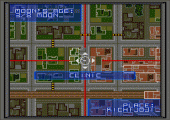
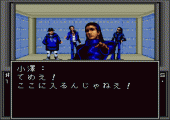
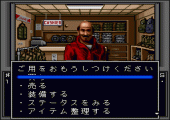
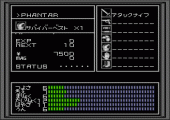
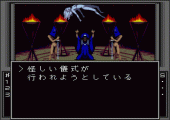
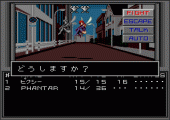
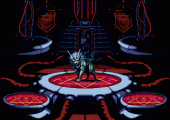
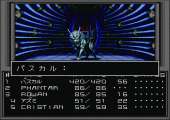
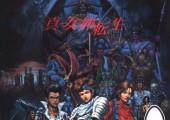
Recent Comments